Many consider the Chinese goose to be one of the most elegant and beautiful members of the goose family. Due to its long neck and exquisite looks, it is sometimes called the “Swan goose.”
In other parts of the world, there are other names for this eye-catching goose. For instance, the French call it “Oies de Chine,” while in Germany, they call it “Hockerganse.”
The Chinese goose has some characteristic qualities. This breed makes loud and frequent noises, and it also produces a high quantity of eggs.
The loud noise makes it an excellent watchdog against predators.
While they are pretty aggressive and independent, this bird can also be quite docile. Sometimes they just prefer to stand around your feet!
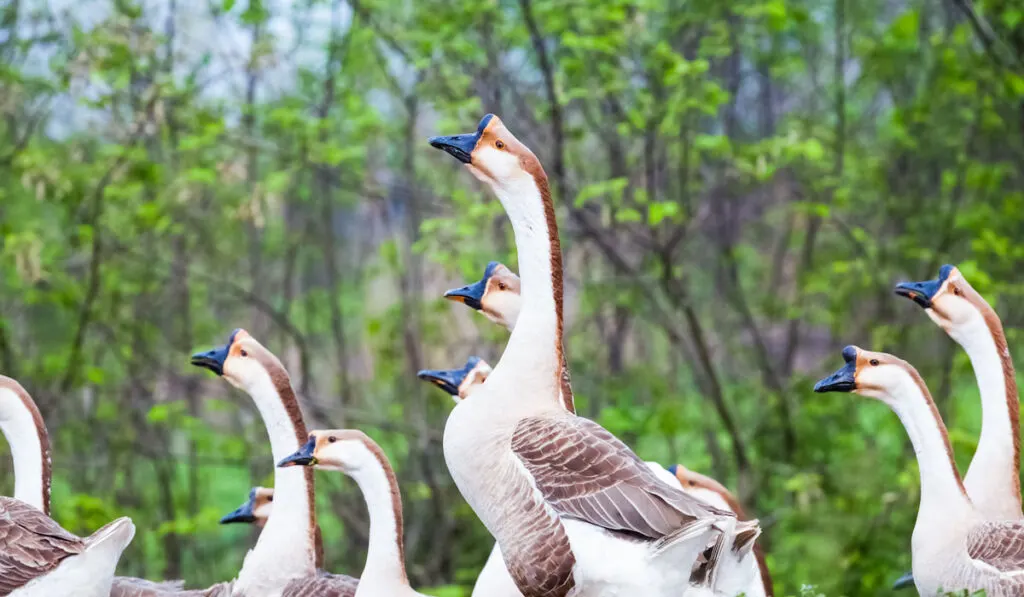
Table of Contents
History and Origin
The Chinese goose breed originated in Asia. Like the African goose breed, they are descendants of the wild Swan goose.
In the UK, there are two different varieties of the Chinese goose.
One is a graceful exhibition variety that emerged in the United States in the 1970s. The second one is a heavier multi-purpose utility variety that is better at producing eggs.
In 1874, the American Poultry Association (APA) recognized the white and brown varieties.
The Chinese goose appeared in the first formal world expo held in Philadelphia in 1876. During this event, the Centennial International Exhibition featured them as “Chinese Swans.”
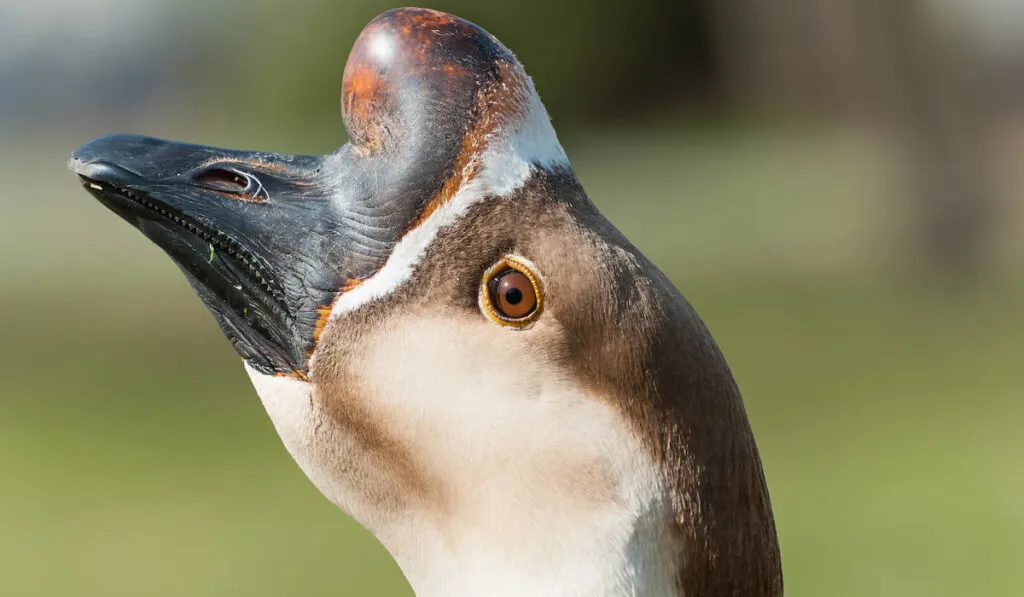
Characteristics
Chinese geese are brown or white and are known for the big hump on their beak. For good reasons, this goose is one of the most popular domestic waterfowl breeds.
It’s ideal for weed control, as well as egg and meat production.
Prolific Layers
With proper care, the Chinese goose can lay more than twice the number of eggs that other goose breeds lay.
Active Foragers
These geese are active foragers and eat weeds, grasses, and other plants. If you have a large grassy area for them to forage, you might not need to add additional feed!
However, you can feed them waterfowl pellets if you have a smaller space or if the weather is cold.
Social
Chinese geese are very social and often stay close to humans.
They can live and mingle well with ducks and other geese breeds.
Plenty of Water
Although the Chinese goose doesn’t require ponds to thrive, this breed needs fresh drinking water that is at least four inches deep.
Like most other waterfowl, they enjoy bathing, playing, and mating in water, so a kiddie pool or a trough can help keep them happy and clean.
Otherwise, they can falter and lose stability in shallow water or on land.
They adapt to almost any climate, but they appreciate small bodies of water to dip their bills.
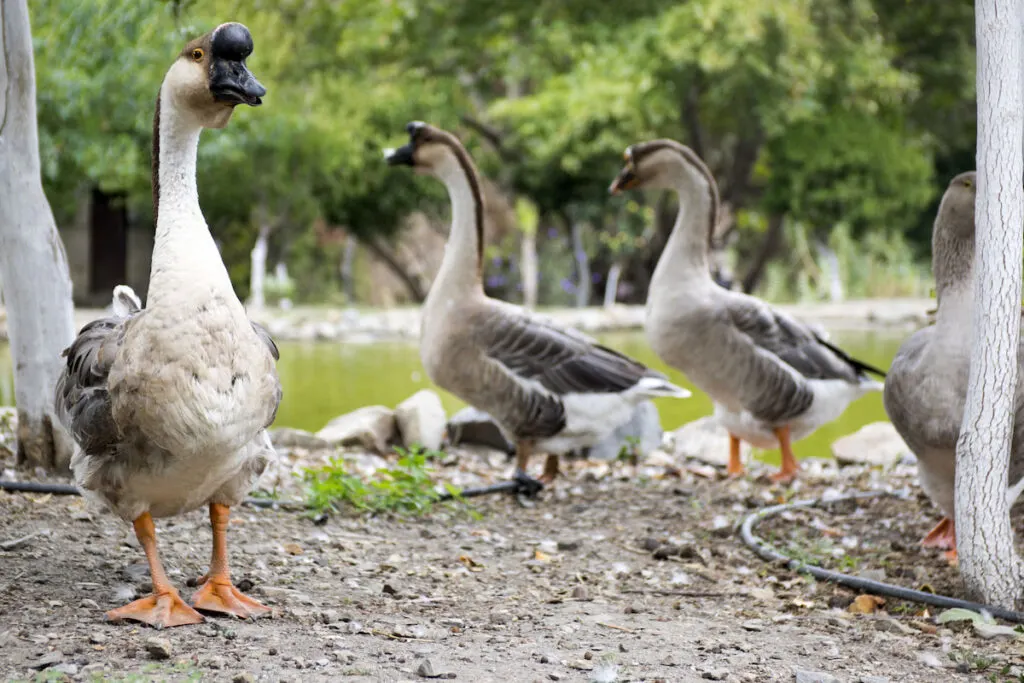
Behavior
The Chinese goose is known for its loud and varied vocalizations. If you enjoy birds that like to make their presence known, you’ll fall in love with this breed.
They are unsuitable for urban farms, as their noisy honking may irritate your neighbors.
And while they are social, curious, and intelligent, they are naturally suspicious of unfamiliar human beings.
As pets, they can become attached to those they see often; if you talk to them, touch them, and give them treats, they will grow to be very tame.
Appearance and Varieties
Chinese geese are exquisite and curvaceous. They are easily recognizable by their knobby and relatively long, slender bills.
They have short bodies and hold their heads upright on a slim, well-curved neck that joins the body at a 45-degree angle.
They develop a basal knob at the top of their beak, which is more prominent in males than in females. The knob grows as the male goose matures.
The knob becomes pronounced at six to eight weeks of age, and you can use it to tell their gender. It is soft, non-scaly, and warm to the touch.
This breed has a protruding, well-rounded chest and a smooth breast.
Mature male Chinese geese weigh ten to twelve pounds (4.5-5.4 kg), while their female counterparts weigh eight to ten pounds (3.6-4.5 kg).
Like other goose breeds, Chinese geese have waterproof feathers. They have preen glands, which secrete oil that they use to rub on their bills and lather their feathers.
Usually, male Chinese geese stand more upright than females. They hold their heads upright with their beak pointed upwards.
Female geese have more horizontal postures and hold their heads level or pointed slightly downwards at the end of their graceful and well-arched necks.
There are two main color varieties of the Chinese goose: white and brown.
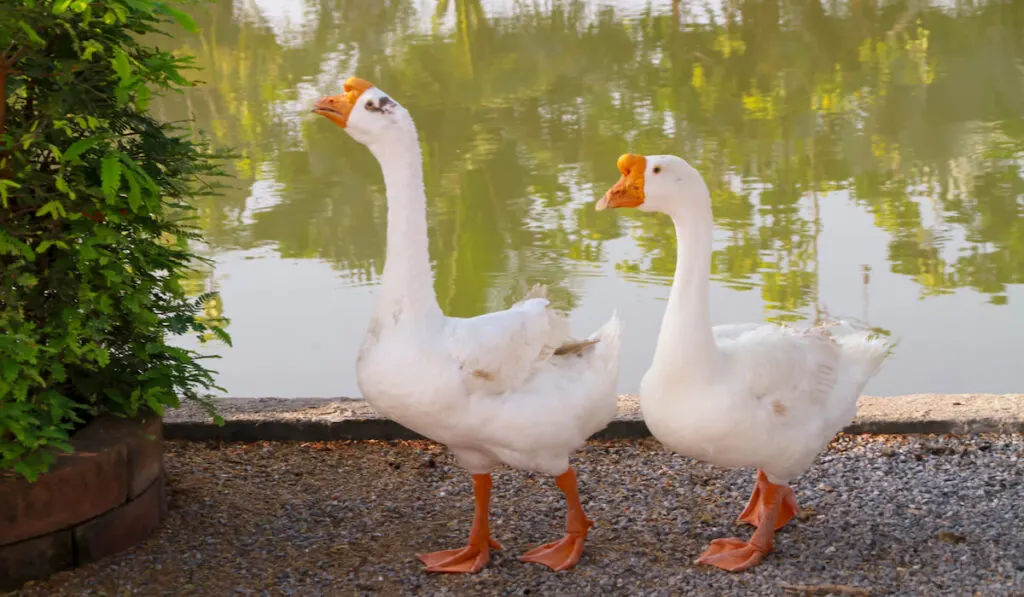
White Variety
The white Chinese goose has pure white plumage with blue eyes and bright orange feet, bills, and knobs.
Their goslings are bright yellow, while the brown goslings are yellow and gray.
Brown Variety
The brown type has a dark brown beak, fawn-colored sides, a brown back, a light-colored belly, and russet brown neck stripes.
In addition, they have glossy black bills and knobs, brownish-orange feet and shanks, and brown eyes.
Neither variety has lobes, keels, or dewlaps.
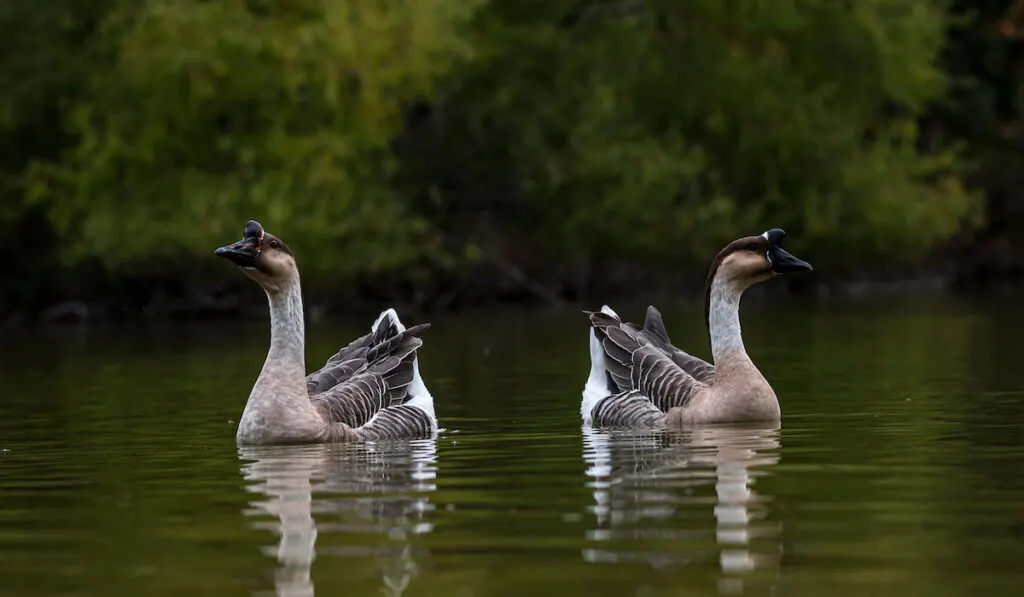
Uses
Weed Control
Historically, poultry farmers reared the Chinese geese for weeding purposes. Some farmers still use them today for this purpose.
Egg Production
Chinese geese are avid egg layers, and many farmers keep them for egg production. They are one of the best egg-laying goose breeds.
The Chinese goose starts laying eggs at about seven months of age and can lay between 40 and 100 eggs annually.
Their eggs are white and weigh 4.2 ounces (120 g) on average.
Meat Production
Due to their low weight, only a few farmers keep the Chinese goose for meat.
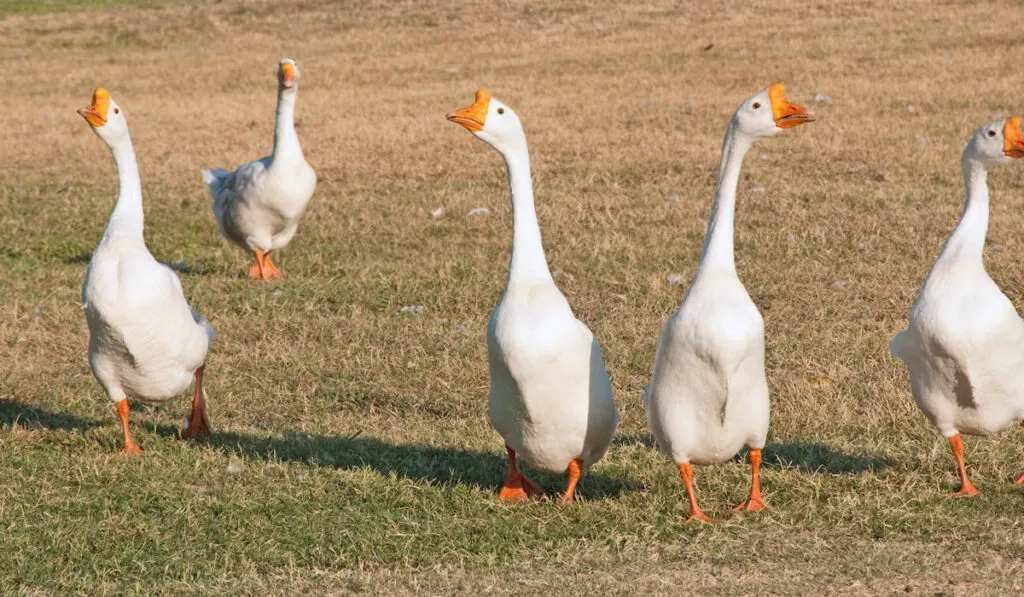
Ornamental Birds
Due to their unique appearance, you can also raise these geese as ornamental birds.
Below is some key information about this breed:
| Breed name | Chinese goose, Swan goose, Weeder goose |
| Other names | Hockerganse in Germany, Oies de Chine in France |
| Varieties | White and brown |
| Lifespan | Approximately 40 years |
| Special features | Very active, aggressive ganders, great foragers, excellent guards |
| Weight | Males: 10-12 pounds (4.5-5.4 kg); Females: 8-10 pounds (3.6-4.5 kg). |
| Climate tolerance | Tolerates all climates, but requires shelter in colder climates |
| Egg production | 40-100 eggs in the breeding season |
| Uses | Eggs, meat, weed control, ornamental purposes, watchdogs |
| Easy to keep | Yes |
| Egg color | White |
| Flying ability | Poor |
| Egg size | Large (approximately 4.2 ounces) |
Fascinating and Fun Facts
- Governor Morris gifted George Washington a pair of Chinese geese in 1788.
- The Chinese goose is related to the wild swan.
- Many consider them attractive watchdogs, thanks to their loud honks when they sense danger or something unusual.
- Some farmers nickname them “weeder goose,” due to their ability to control weeds and pests.
- Their goslings can bond to anything they see when they first hatch.
- The Chinese goose is the smallest domesticated goose breed.
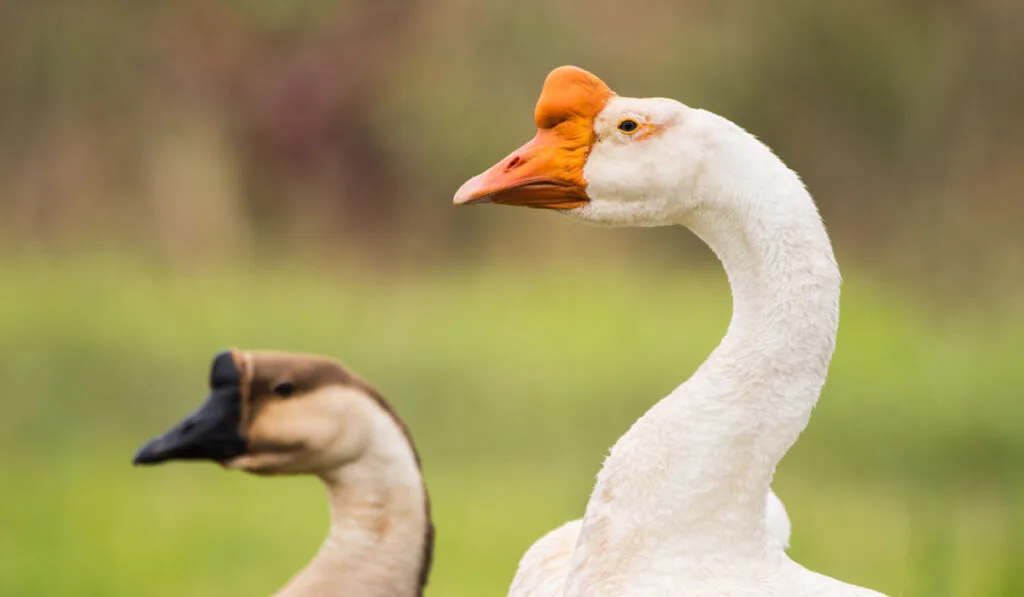
Frequently Asked Questions (FAQs)
The Chinese goose is excellent for laying eggs and weed control. You can also keep them for meat.
The Chinese geese make wonderful pets if you get them used to human interaction at a young age. They form strong attachments to each other, other animals, and humans.
Yes, the Chinese goose can fly, but only for short distances.
Chinese geese lay white eggs.
The significant difference between African and Chinese geese is their size. The African goose is bigger and weighs up to 20 pounds. In comparison, Chinese geese weigh approximately 12 pounds.
Domesticated Chinese geese live for approximately 40 years. Wild ones can live up to 15 years.
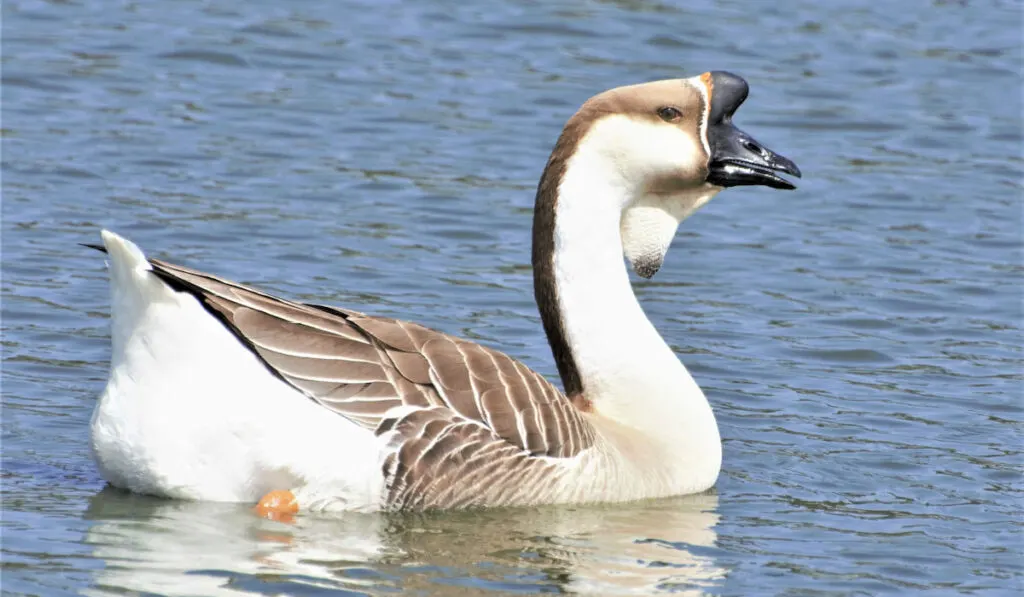
Conclusion
The Chinese goose is one of the most popular geese breeds, ideal for small-scale and first-time goose farmers. This is due to its small size, prolific egg-laying, and easy maintenance.
One major drawback is that they’re noisy birds. Thus, they may bother your neighbors if you rear them in urban settings.
Otherwise, they are social and great multi-purpose birds. You will fall in love with these friendly and elegant geese.
While they are known for being noisy, they have much to offer. You can keep this breed for its large eggs, delicious meat, and weed-control abilities. Best of all, they are easy to maintain!
Resources
I wrote this article from my experience raising geese and the following sources:
- https://livestockconservancy.org/heritage-breeds/heritage-breeds-list/chinese-goose/
- https://www.waterfowl.org.uk/domestic-waterfowl/domestic-geese/chinese-goose/
- https://breeds.okstate.edu/poultry/geese/chinese-geese.html?Forwarded=afs.okstate.edu/breeds/poultry/geese/chinese
- https://www.poultryhub.org/all-about-poultry/species/fancy-goose-breeds
- https://oakvalewildlife.com.au/explore/our-animals/brown-chinese-goose
- https://amerpoultryassn.com/accepted-breeds-varieties/
